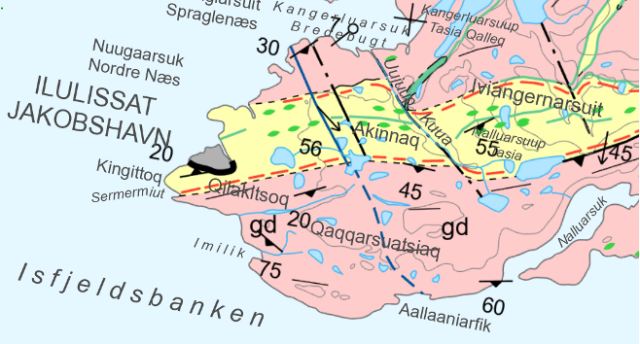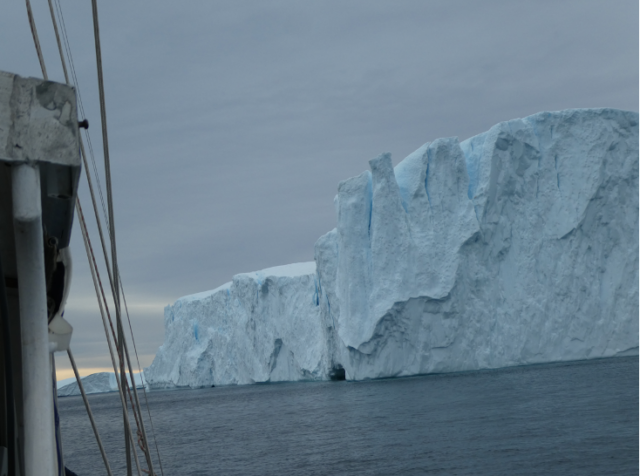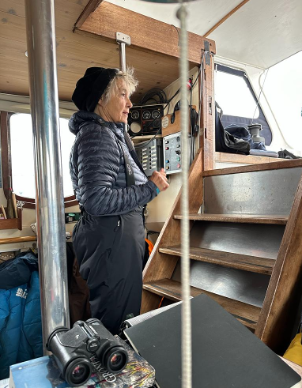Skin and Ice – Residency aboard Skydancer – Greenland

Geological Time and Stone Turntable R&D – 4
https://vimeo.com/1059292914 🎧
Abord Skydancer – at the Eqi Glacier
The Greenland residency was a 10 day exploration of the west Greenland coast line starting and ending in the southern region of the arctic in the Port of Illulisat 69°13′N 51°06′W. August 2023. This exploration was taken aboard Skydancer, a 20m long two masted cutter with a Norwegian crew of two and in the company of 10 European and American artists. The expedition was planned and organised by artist Lena von Goedeke/ Satellite Institute /Svalbard. https://www.vongoedeke.com/news/satellite
We travelled from Illulisat north to the glacier Eqi and then through Disko Bugt / Qeqetarsuup to Disko Island/ Qeqertarsauq, then returning to Illulisat.


Left Here’s Eqi glacier
Right Arctic region
I experienced a bit of the vast the continent mostly from the coast. In the time I had there, I wanted to find what I could of the land and its people with a focus on notions of ‘time’ and how this differed from notions of time I have. My own means of getting closer to experiences is to record sound.
With extremely restricted space to store and travel my equipment and the gear I needed for the climate and being aboard ship, I took the minimum and wrapped it in my clothes in my kit bag…
- through water, rock and wood with an Aquerian hydrophone contact mic + extralong cable for lengths in the deeper sea.
- the landscape with a Mix Pre-6, Sound Devices recorder with Sanken CS 3E shotgun stereo microphone and rode modular WX 4 windshield and mount -the windshield being vital for exterior recording especially on the boat.
- the upper atmosphere with radio receiver – WR-3 VLF ‘whistler receiver?
- through rock with a geophone (similar to SM4)?
Listening in, underwater recordings picked up an intimate link to the explosive and odd sounding calving of the glacier and bergs surrounding the boat; like trucks of rubble emptying their load and sometimes like gun shots. It was very noisy and a shock to hear it sound so close to the boat. The sound under the hull of Skydancer opened up a universe of lively sound below the water line bringing to my ears the strange noise of impacts and the clashing of powerful materials.
https://soundcloud.com/shirley-896949324/underwater-calving-ice-bergs-2 🎧
https://soundcloud.com/shirley-896949324/underwater-calving-icebergs-1 🎧
https://soundcloud.com/shirley-896949324/hoisting-the-anchor 🎧
https://soundcloud.com/shirley-896949324/tsunami-waves-from-the-eqi-glacier 🎧

The Skydancer at anchor
Here’s the Sanken shotgun mic picking up from a distance. Listening to the Loons at Ritenben
https://vimeo.com/1059295399 🎧
Our safety talk re the polar bears from the skipper: “….they usually are afraid because they are hunted here. Lena has a flare gun – if they approach which she will shoot towards it. If they are angry and approach we huddle together and make a very loud noise.”
(Well that puts that in perspective, then!)

Here we are with the on-board air rifle shooting practice at ice in the water. Not a gun for the bears but for safety.
Aboard Skydancer, I began to understand that the sea, the need to keep water and food and warmth on our boat, the understanding of the tides and nourishment from the icy sea keyed into our survival. We had to dodge the wilful rogue and fast movement of the ice bergs travelling dangerously at speed round us. A third of an iceberg is visible with two thirds underwater and if they flip over can easily capsize a small boat. This Iceberg (in the picture below) appeared next to the boat on our mooring. It needed to be fended off delicately with a long pole.

Rogue Iceberg being poled off the boat at Qete by Lena
Here’s the contact mic on black ice.
https://soundcloud.com/shirley-896949324/noisy-black-ice 🎧
Time here is the ability to live at the pace of the seasons and weather conditions. People’s ability to survive is completely related to the light in the length of daylight, dark night through winter and almost permanent daylight through summers. I learnt that along with the restrictions of fierce seasonal temperatures were travel restrictions, where the connections between villages town and the capital Nuuk, is dependent on boat, dog sleds and small planes, the entire continent being completely devoid of internal roads.
Huskies in the town – food’s coming!
https://vimeo.com/1059428637 🎧

Qertaq – You can see the different coloured houses. Each colour informs what the house is for. Blue for power, police, help, Church. Red for supplies. Yellow for education and health etc
Beyond My Vision
Even in the present time Greenland has hidden depths under the continents snow and ice, 35miles deep in some places, and the situation of climate change being critical, the exact depth below the continent’s thick ice is still not accounted for. Under our boat as we sailed, was dark deep water with maritime mammals and unknown life beyond my vision that I could only guess at.
Greenland coming into view – well not green it seems…
I listened to this description of what was underneath, beyond view, the Greenland continent on the plane coming into Illulisat when I sat next to a geologist who was working on a climate change project. Her group of scientists were gathering information about an area in the north of the continent where they were exploring an underground – or under ice, valley that was now, due to climate change, filling with sea water. They wanted to determine if this salt water would melt the ice above it slowly or crack it fast. Either way it wasn’t going to be a good outcome for who lived there- mainly Inuit.
Greenland is not only the fast-moving climate reacting continent of change with its ancient thick ice, but speaking with geologist Beth Simons I found later that underneath where I stood in Illulisat was some of the oldest formed rock on the planet. Beneath the snow and ice is largely gneiss (yellow on the map) and granite (pink). The gneiss is known as the Nuk gneiss and this was formerly a granodiorite (igneous rock) that has been metamorphosed. The pink is mixed granodiorite (like a granite but with less silica) and Finnefjeld gneiss. Both are Neoarchaen to Mesoarchaen in age (3.2-2.5 billion years old). Described to have existed since the Hadean Eon volcanic ‘hellish’ period of earths’ evolution.https://www.earth.com/earthpedia-articles/hadean-eon/

Equally beyond my vision below the surface of the sea, I was unable to see the marine life, unless they chased the boat and appeared at the surface. At every opportunity I thew my hydrophone overboard to catch the Fin Whales calling.
https://vimeo.com/1059297217 🎧
Fin Whale – with their waterspouts
I found out however that the oldest living vertebrate living in the arctic oceans – the Greenland Shark had been “….wandering the Arctic Ocean since 1627”. How could they tell this? On board the Skydancer was Artist Tamara Enz, a biologist photographer and writer, who answered my enquiry about measuring the longevity of the Greenland shark. She described her colleague and friend, Craig George, developing the technique to age whales by finding the its age by removing the layers of the lens of its eye—which continues growing throughout its lifetime—and radiocarbon dating the tissue in the centre. https://www.nationalgeographic.com/animals/fish/facts/greenland-shark
The Greenland shark the deepest fish ever filmed. At a depth of 8,336 meters at 27,000g pressure. that’s 5.179 miles down. “They have a life expectancy of at least 272 years and could reach 392 years old – give or take about 120 years. What’s more, these slow-growing creatures don’t reach reproductive age until around 150 years old”. I just had to write that out as it’s extraordinary to me.
And for future listening to marine life – live, the new underwater listening station at Qaqqaliaq in Qeqertarsuaq can be accessed at https://diskolive.com/sounds-underwater
Culture
We sailed in the Skydancer across Qeqertarsuup Tunua or the bay Danish Disko Bugt , mooring in the port at Disko Island, called Qeqertarsuaq in Inuit. In the dock the Skydancer moored up to a large ish rough and ready tourist boat. We met a young crew member who came aboard the Skydancer for a beer, and we got to asking about her amazing tattoos. They featured Sedna the Goddess of the sea and for this young crew member was an important strong woman character that she identified with and held important.


The lines across her fingers represents the chopping off of Sedena’s fingers. Now in the present-day young women have these symbols of the abused daughter, depending on which tale you hear, winning out ultimately over the abusive father.
Another young Inuit working at the museum showed me a children’s story book about a character called Kaassassuk (by Tupaarnaq Rosing Olsen/ milk publishing). The violence and brutality, he said, had been reduced for children. The level of critical survival in both encounters showed me how the cultural stories handed down were important to the present-day Inuit youngsters. From the museum and art centre I could see that the symbols tattooed on skin, carved in or burnt in wood and bone and sewn in animal hide or platted into hair, expressed beliefs, told stories or reminded the people of their spirit life.https://visitgreenland.com/articles/a-guide-to-inuit-tattoos-in-greenland/
“The art of Inuit tattoos is called Tunniit. The process and method are colloquially called Kakiorneq in West Greenland and Kagierneq in East Greenland.” – “For the Inuit, the ‘sacred’, spiritual and religious are everything that surrounds us, and everything is animate and alive in that worldview.” – “Their first Tunniit is the Talloqut, the chin tattoo that women receive when they enter the role of woman. The forehead tattoo is in honour of Maliina, the sun.” Chin and forehead tattoos are explained but this is lovely – “While the amulets on the legs were to ensure future children and that the first a child saw at birth was something beautiful.”

Hand made items in the museum at Qeqertarsuaq
Cultural beliefs were etched into the materials around daily life. Even now tools, electricity and materials are available but scarce. In some places because of the fierce over riding weather, the temperature, the light and remote situation of the settlements – these tools have a value we (from temperate climates) can’t grasp. The practise of etching into materials made an impression on me and I thought about it bringing a value to the interface between material and human.

Football Club G-44. The pristine pitch at Qeqertarsuaq or Disko Island – ice bergs floating directly behind in the bay.
Returning to Illulisat we encountered the hill sized floating ice bergs from its adjacent Glacier, Sermeq Kujalleq. More bergs moving at speed. Here below are much bigger bergs! It was said that – “take your eyes off them and the sneak up on you, a bit like the game ‘grandmothers footsteps’,


The book – About Illulisat Icefjord
Illulisat’s fjord, Kaniata Sullua is fed by the glacier Semeq Kujalleq. https://kangia.gl/fakta-om-isfjorden/navngivning?sc_lang=en . The resulting ice bergs in the sea around this area are like veritable mountains. We motored through them in a freezing fog.
Although I was learning about the surprising speedy mobility of icebergs, in this short trip it was evident that the country was in change on all fronts with climate change and the opening up of mines – popular interest from other powerful countries. The steady and continual lobbying from the indigenous people for their balance of control in the parliament with the Danish protectorate being highlighted by all the change of focus on the country.
Nature throughout continues to strive. Here’s a recording from earlier at Eqi Glacier. Birds are flocking to get the summer arctic food that’s abundant near the glacier ice face. The birds are stocking up now summer is turning to autumn. I heard several species calling here. The Skydancer’s diesel engine is taking us through the ice and several crunches can be heard against the lumps impact on the hull.
https://soundcloud.com/shirley-896949324/sea-birds-at-eqi 🎧

Photo Bonnie Levinthal
We all had our turn on watch!
This residency has contributed to Geological Time and Stone Turntable R&D project. Other parts of this R&D can be seen here on this website called The Groove, Sonic Rock Interactions and Flags on the Beach.
END